Russia has created a prototype of an interceptor drone. The Tarantula Birdcatcher drone was developed by Altai intelligence officers and is equipped with trap nets to intercept UAVs. In the video you can see how this drone works. The trap is not fired forward, but downwards, which makes it possible to confidently intercept only hovering drones; it will be more difficult to intercept moving UAVs. The new drone is being tested, there is no technical information, and funding is needed for serial production.
You are using an out of date browser. It may not display this or other websites correctly.
You should upgrade or use an alternative browser.
You should upgrade or use an alternative browser.
Russian Air Force (VVS)
- Thread starter Deino
- Start date
Footage of work in Ukraine, a Russian drone with a target designation system. The operator, in real time, selects targets on video from the drone and transmits data with coordinates to artillery units. Judging by the video, the software package loads Google maps and is used to link to the area. The video shows artillery, presumably a mortar, being aimed at a Ukrainian BMP-2.
After being hit by one of the mines, the BMP-2 leaves the battlefield. The drone model and what kind of software it is are not reported.
After being hit by one of the mines, the BMP-2 leaves the battlefield. The drone model and what kind of software it is are not reported.
Flotilla
Full Member
- Dec 23, 2023
- 266
- 313
This ain't right!
(Warning, harsh language)
Too much fentanyl...
GoMig-21
Elite Member
- Oct 16, 2016
- 9,165
- 14,229
- Country of Origin

- Country of Residence

Too much fentanyl...
Is that what it is? lol. Yeah the poor thing takes a beating without a doubt. Then they added the ultimate insult to injury by nicknaming it the 'Felon' I mean really? Even the worst thrash metal band or gangsta rap duo would shy away from naming themselves Felon for crying out loud lol.
I personally very much like the aircraft and think it most likely has a very decent low RCS just by virtue of its all-around design & shape, especially its slim profile. If there is any knock on the F-22 is the size of its side profile with those ginormous canted vertical stabilizers. Compare them to the much smaller ones on the Su-57. But then again, it's not really about size as much as shaping and angles.
Plus the Russians have always been pragmatic about their designs and always prioritized certain aspects over others sometimes contrary to the US & West. So I think the jury is still out since we still haven't really seen any in-air testing of any kind to judge levels of stealth, be it for the F-22 or J-20 for that matter. The latter even gets a huge beating for its canards. But because it shares a lot of other similarities to the Raptor (stealth edge, RAM color etc.) it gets a little beat less of a stomping than the Su-57. The one thing that does bother me the most on this thing, though, is the paint job. I'd like to see a much more uniform color that has some resemblance to a working RAM. Even the Su-75 Checkmate seems to be heading in that direction with a uniform color. Not sure what the digital camo infatuation is all about.
Bengal71
Senior Member
- Sep 21, 2018
- 4,724
- 4,918
- Country of Origin

- Country of Residence

Not sure what the digital camo infatuation is all about.
It looks cool.
Fatman17
THINK TANK: CONSULTANT
- Apr 24, 2007
- 36,877
- 43,249
- Country of Origin

- Country of Residence

RUSSIAN SUKHOI FIGHTER PROFILES
- Aviation Features
- Russian Sukhoi fighter profiles
By Alex Mladenov 6th May 2022
FEATURE
Sukhoi create aircraft suitable for a myriad of roles such as, close air support with the Su-25 all the way to supression of enemy air defences with the Su-34. Alex Mladenov brings insight into the roles and capabilities of the diverse range of aircraft provided by the manufacturer.
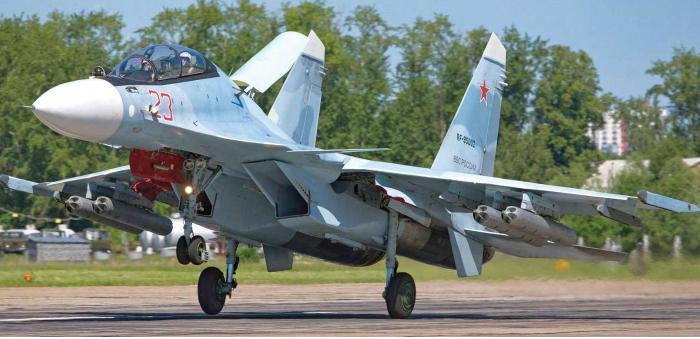
The thrust-vectoring Su-30SM is a true multirole heavyweight fighter, which has been used to replace the MiG-29 in three RuASF frontline fighter regiments, stationed at Domna (120th IAP), Millerovo (31th Guards IAP) and Kursk (14th Guards IAP). The type is also operated by the Lipetsk combat training center, assigned to the 968th IISAP
Andrey Zinchuk via Alex Mladenov
Jsc Sukhoi is a major Russian aircraft manufacturer that has in recent years diversified into the civilian sector too. It has a rich tradition in fighters, having spawned 16 different ones since 1955 with the types synonymous with the Cold War – the Su-7 Fitter-A, Su-15Flagon and Su-17/Su-20 and Su-22 Fitter-D all gone. Sukhoi has built and delivered around 4,500 fighters since then and details of those different types feature in our coverage here.
Meanwhile, Sukhoi is working on the multirole fifth-generation twin-engine Su-57 Felon and single-seat Su-75 Checkmate. China has also built derivatives of the Su-27 (J-11), Su-30 (J-16), Su-33 (J-15) and Su-35 (J-11D), while Hindustan Aeronautics Ltd (HAL) assembled more than 200 Su-30MKIs under license at Nasik.
Fighting Ukraine
Sukhoi fighters have been at the forefront of Russia’s airborne attacks; they are all very capable bomb trucks or air defenders.
What they don’t seem to be good at is the electronic warfare game, and using self-defense systems to protect themselves against Ukraine’s man portable air defense systems (MANPADS) or the bigger integrated air defense systems. Perhaps they don’t do as much training in this sphere as they should. Or maybe they were not expecting the Ukraine air defenses to be so good.
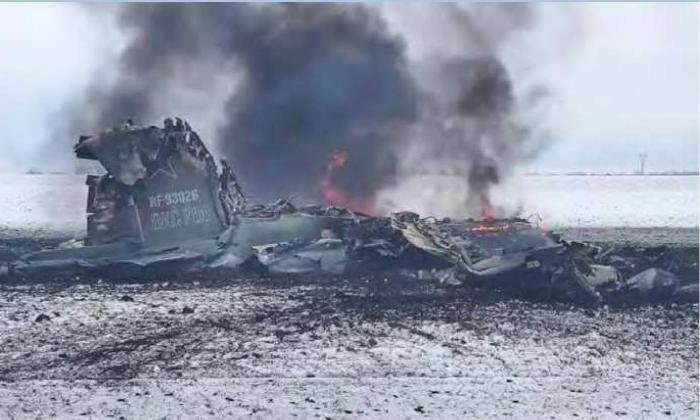
The still burning wreckage of Russian Air Force Su-25SM3 RF-93026 after it was shot down by Ukrainian forces on March 4 near Volnovakha in the Donetsk region of Ukraine
Ukraine MoD
Around 800 Sukhois are either on alert or deployed to western Russia or Belarus, with – not surprisingly – the ground attack Su-25/SM/SM3 and UB Frogfoots, Su-24M/MR Fencers and Su-34 Fullbacks being the most numerous. Other types being used in large numbers are Su-27s, Su-30M2s, Su-30SMs, Su-35S and Navy Su-33s.
Losses
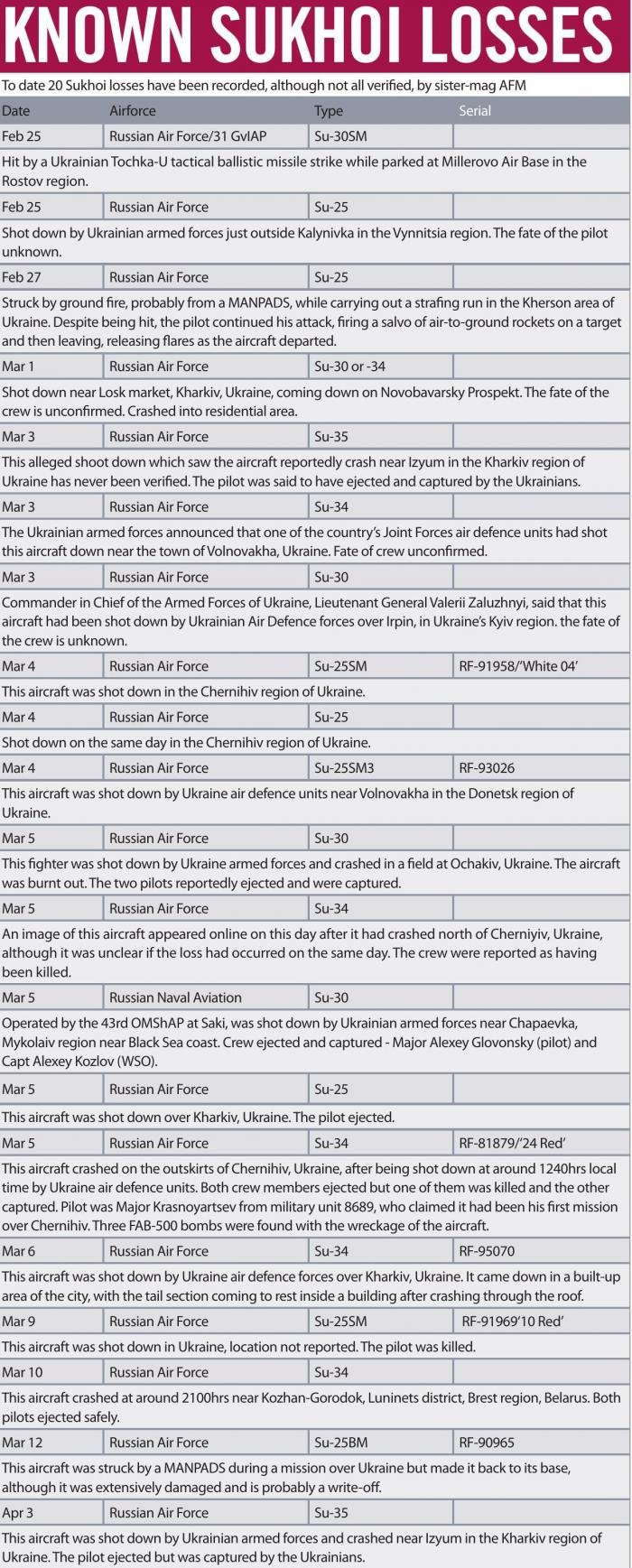
Su-24
NATO designation: Fencer-DFirst flight: June 23, 1977
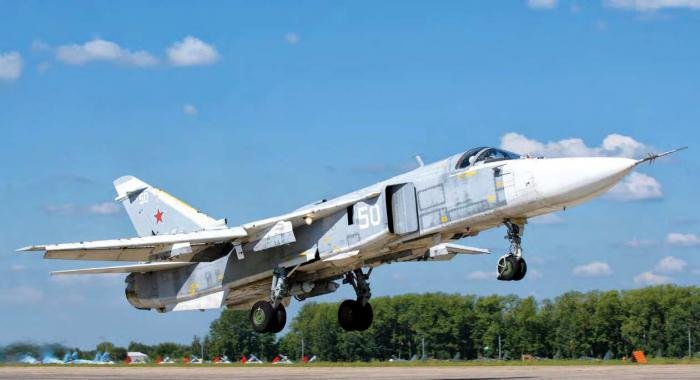
Above: Russian Air Force Su-24M (RF-90772) assigned to Marinovka Air Base, part of the 4th Air and Air Defence Forces Army in the Southern Military District. The base is home of the 11th Composite Aviation Regiment (11th SAP) which has two squadrons of Sukhoi Su-24M/MR. The aircraft is seen taking off from Dyagilevo air base – Russia during Internatioal Aviadarts 2018, loaded with two OFAB-250 ShL 250 kg High-Explosive/Fragmentation bomb. The type of bombs that are likely to be used on Ukraine targets Giovanni Colla
The Su-24 was initially developed as something like a ‘carbon copy’ of the General Dynamics F-111, following a very similar design concept and tasked with the same mission set. The crude and notoriously unreliable initial version, designated Su-24 (NATO reporting name FencerA/B/C), underwent a protracted and fairly comprehensive development program over a decade, which eventually resulted in the vastly improved Su-24M in the second half of the 1970s. This was, in fact, the ultimate strike Fencer that entered squadron service in the early 1980s and was kept in production until the early 1990s.
The swing-wing bomber combines in a single airframe a short field performance, long range, a heavy warload and a highly sophisticated nav/attack suite enabling all weather operation and ordinance delivery in all conditions, day and night, at terrain following low-level supersonic flight.
The Su-24M also introduced a retractable refueling probe and additional avionics boxes, while the rounded rear fuselage featured a smaller cross section in order to reduce drag. The expanded guided weapons options offered by the new nav/attack suite, the PNS-24M, became possible thanks to the integration of the sophisticated Kaira-24 TV/laser targeting system. The Fencer-D also got the sophisticated BKO-2 Karpaty self protection system incorporating an SPO-15S Beryoza-S radar homing and warning receiver, a Geran-1FU or -2FU active radar jammer, an L-082 Mak-UL1 ultraviolet missile approach warning sensor and two 12-round APP-50A chaff/flare dispensers.
For self-defense, the new Fencer version was made capable of deploying two R-60 short-range air-to-air missiles. The total Su-24 production numbered 721 examples, in addition to about 500 Su 24M/MK/MR/MPs.
Derivatives
Su-24M Gefest &T upgradeThe SVP-24 modular digital upgrade package for the Su-24M was originally developed by the privately-owned, hi-tech company Gefest &T in the late 1990s for a significant yet low-cost improvement of Fencer-D’s navigation and weapons delivery. The upgrade also boosted the Su-24M’s overall combat survivability, maintainability and mission planning effectiveness.
The SVP-24 package is built around the SV-24 mission computer integrated with a combined GPS/GLONASS satellite navigation receiver, new hardware interface units and dedicated mission software for processing navigation data received by a number of different sources.
It allows for drastically improved accuracy of delivering unguided weapons. As of 2018, the RuASF and RNA fielded 50 Fencer-Ds upgraded to this standard.
Below: This is one of the 28 Su-24MK Fencer-Ds still in service with the Iranian Air Force. Since 2009, the 72nd Tactical Fighter Squadron has always kept a fleet of 12 of these bombers operational Babak Taghvaee
Su-24M2 upgrade
The Su-24M2 upgrade program, undertaken by Sukhoi in the early 2000s under the code-name Gusar, had limited success due to its high price combined with unimpressive increase in the aircraft’s overall combat effectiveness at the time. The Su-24M2 standard added a new digital mission computer, an ILS-31 HUD, color displays in front of the navigator/ weapons system operator and a series of navigation improvements, new radios and a flight data recorder.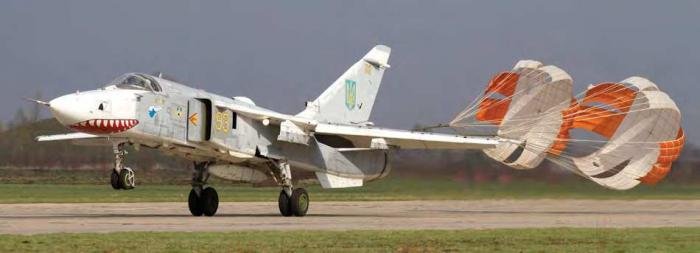
Right: This 7 BrTA Su-24MR 93 yellow lands at Starokostyantyniv showing an early deployment of its brake chute Chris Lofting
A total of 28 Fencer-Ds were upgraded at Sukhoi’s Novosibirsk-based aviation plant between 2006 and 2009.
Fatman17
THINK TANK: CONSULTANT
- Apr 24, 2007
- 36,877
- 43,249
- Country of Origin

- Country of Residence

Su-24MR
The Su-24MR Fencer-E was designed for performing all-weather, day/night reconnaissance over land and sea, at up to 210nm behind the front line. This version, based on the Su-24M’s airframe, had no air-to-surface attack capability and retained only the Relef terrain avoidance radar for ultra-low altitude flying in automatic mode.Below right: The Libyan Air Force operated six Su-24MK Fencer-Ds from February 1989, until NATO airstrikes destroyed five in February 2011 and the survivor was shot down on March 5, 2011. Haftar’s Libyan National Army acquired two Su-24Ms in May 2020, but their status is unknown. Alan Warnes
The 1980s-vintage BKR-1 multi-spectral reconnaissance suite comprised the Shtyk side-looking radar, an A-100 wet-film camera under the port engine intake used for oblique photography and the AP-402P low-altitude panoramic camera in the nose. The wet-film cameras were augmented by the Aist-M TV-camera and the Zima IR scanner installed under the fuselage. The BKR-1 suite also incorporated two types of pod suspended below the fuselage. One housed the Shpil-2M laser scanner, useful for low-altitude reconnaissance, while the second one was represented by the SRS-13 Tangazh ELINT system. In addition, an Efir-1M radiation detection pod could be installed under the movable panel of the starboard wing. The Su-24MR could be armed with a pair of two R-60M (AA-8 Aphid) short-range air-to-air missiles for self-defense.
In service
The first production-standard Su-24s for the Soviet Air Force were taken on strength in 1973. The Su-24M was fielded in experimental service in 1981. The Fencer-D’s operational use in the Russian invasion of Ukraine includes flying battlefield air interdiction missions, while the Su-24MR is tasked with air reconnaissance, flying low and medium altitude missions. As of April 5, 2022, there were no confirmed combat losses.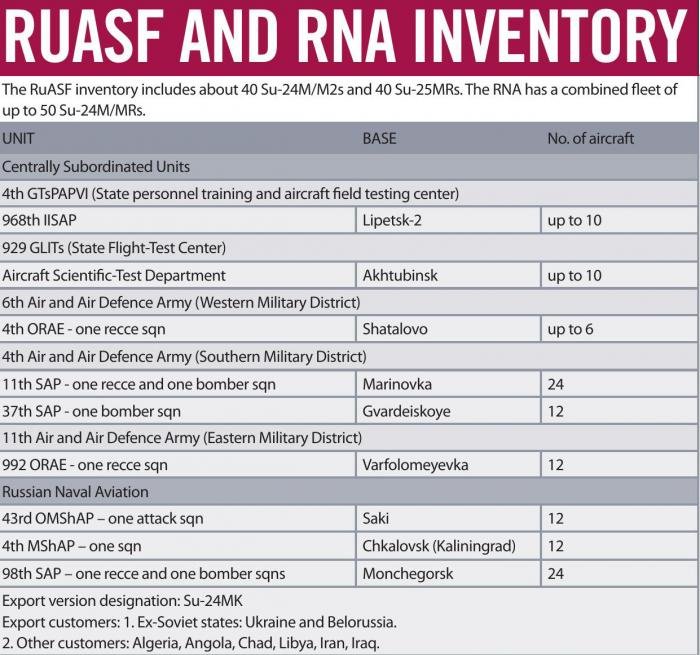
Su-25
NATO designation: FrogfootFirst flight: February 22, 1975
The Su-25 is the first Soviet mass-produced combat jet, purposely designed for the close air support (CAS) role; as such it represented a simple, effective and survivable attack workhorse. In its original guise, the Frogfoot was designed to fly short-range/low-level battlefield CAS missions and, since the early 1980s, the type proved itself as a powerful and cost/effective machine for this rather dangerous job.
The rugged, agile and simple Su-25 is a short-legged, armor-protected attack aircraft, capable of reaching targets at up to 160nm from its take-off airfield when operating with up to three tons or ordnance and two external fuel tanks.
The production run between 1978 and the early 1990s accounted for no fewer than 582 Su-25s, 50 slightly improved Su-25BMs, and 182 Su-25Ks for export customers built at the TAM plant in Tbilisi, now in the independent state of Georgia. In addition, some 140 to 150 more Su-25UB/UBK two-seaters, retaining full combat capability, were rolled out at the Ulan-Ude Aviation Plant (U-UAP) in Russia.

Below: Su-25 ‘41 blue’ of the 299 brTA on the flightline at Ivano Frankivsk in September 2013 for an exercise near Lviv. Chris Lofting
Derivatives
Su-25SM upgradeThe SM upgrade standard, developed in the early 2000s, brought the Frogfoot’s analogue mission suite into the modern digital age. It incorporates the PrNK-25SM Bars nav/attack suite using a BTsU-25 mission computer to facilitate integration of digital systems and weapons. The avionics package also featured a new KAI-1-01 HUD and a multifunctional color display to improve situational awareness – showing a digital map, flight/navigation, and tactical information, in addition to a much more accurate navigation system, based on an all-new Ts-061K inertial gyro-reference system, which receives corrections from the A-737-01 GPS/GLONASS satellite navigation receiver. The self-protection capability against radar threats has been boosted up thanks to the integration of the new L-150-16 Pastel radar homing and warning system (RHWS) and the guided weapons suite was expanded with the R-73 (AA-11 Archer) highly agile air-to-air missile. As many as 84 aircraft were upgraded, including 40 to the slightly improved Su-25SM2.
Su-25SM3 upgrade
This is the most sophisticated upgrade standard for the RuASF Frogfoot fleet, developed in the mid-2010s. Aimed mainly to strengthen the Frogfoot’s self-protection and night-operating capabilities, it integrates new hardware and software enabling it to employ new guided weapons day and night. The SM3 also boasts an encrypted datalink for use in CAS scenarios for exchanging targeting information with forward air controllers (FACs) and other aircraft in the air.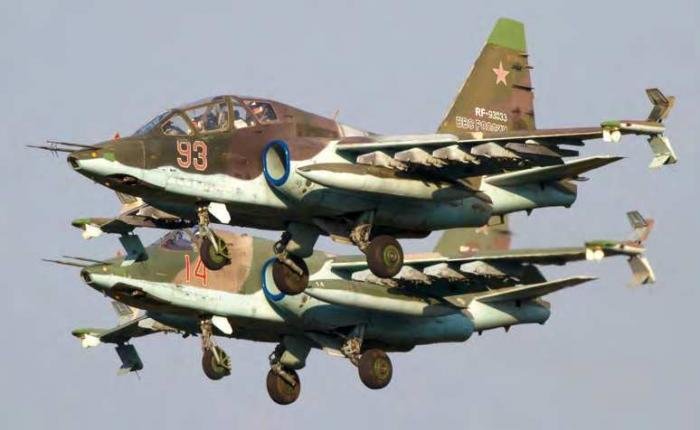
After the Russian Air Force 100th anniversary airshow flypast in 2012, Su-25UB ‘93 red’ RF-93033 from the 6972AvB, 6AvGr, based at Budennovsk performed a pairs landing to Chkalovsky. Chris Lofting

Su-25SMs assigned to Budennovsk air base, home to the 368th Assault Aviation Regiment, which has two squadrons of Su-25SM/SM3s. Here a pair take off from Dyagilevo during International Aviadarts 2021, equipped with rocket pods Giovanni Colla

The upgraded Frogfoot also comes equipped with the enhanced PrNK-25SM-1 nav/attack suite and the SUO-39M fire control system.
Among the main components in the latest upgrade package is the new SOLT-25 IR/TV/laser targeting and designation system installed in the nose to provide day and night capability.
The Su-25SM3’s expanded guided munitions arsenal added the Kh-29T/TD/TE TV-guided missile and KAB-500Kr TV-guided bomb as well as the KAB-500S satellite-guided bombs.
Also, the enhanced Frogfoot features the newly added Vitebsk-25 integrated self-protection suite incorporating the L-150-16M Pastel RHWS, ultraviolet (UV) missile approach warning sensors, UV-26M countermeasures dispensers using a mixture of 26mm and 50mm chaff and flares in addition to the L-370-3S dual-pod radar jammer system, covering the frequency band from seven to 10GHz.
The missile approach warners are incorporated in the Zakhvat electrooptical sub-system using a pair of ultraviolet sensors looking rearwards and sidewards, installed in a V-shaped assembly under the tail.
Fatman17
THINK TANK: CONSULTANT
- Apr 24, 2007
- 36,877
- 43,249
- Country of Origin

- Country of Residence

In service
First production-standard aircraft for the then Soviet Air Force were taken on strength in 1981. The Su-25SM was introduced into regular service in 2006, and the Su-25SM3 followed in 2017.The type’s operational use in the Russian invasion in Ukraine includes flying CAS missions as well as battlefield air interdiction and escort of ground columns. As of April 5, 2022 the confirmed combat losses in the campaign amounted to nine aircraft, including at least one Su-25SM3.

Left: Su-25SM3 (RF-95130) assigned to Primirsko-Akhtarsk air base, taxies out at Dyagilevo during International Aviadarts 2019, loaded with the OFAB 250-270 high explosive fragmentation bombs Giovanni Colla
RuASF inventory
By February 24, 2022, the Russian air arm had a Frogfoot fleet consisting of no fewer than 130 single-seaters of all versions in addition to about 30 two seaters in active service.The Su-25SM fleet numbered between 50 and 60 aircraft in addition to 20+ more Su-25SM3s.
Su-27
NATO designation: Flanker-BFirst flight: April 20, 1981
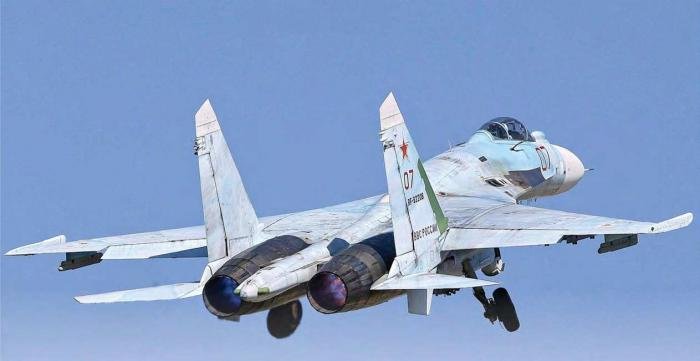
A total of 55 first-generation single-seat Flanker-Bs were originally upgraded to the enhanced Su-27SM standard at KnAAZ in Komsomolsk-on-Amur between 2003 and 2009, followed by 12 more to the further enhanced Su-27SM3 between 2014 and 2018 Andrey Zinchuk
The Su-27 traces its origins back to 1969, when the Soviet Air Force (RuASF) outlined its initial set of technical and tactical requirements for developing a new generation air superiority fighter, viewed as a counter to the US Air Force F-X program that eventually resulted in the development of the McDonnell Douglas (now Boeing) F-15 Eagle. The main objective of the Soviets was to develop a capable heavyweight fighter, well-suited to tight maneuvering, with huge internal volume and a large number of long-and short-range air-to-air missiles. The first prototype, designated the T10-1, made its maiden flight on 20 May 1977 and was followed by three more examples.
However, the aircraft had a notably inferior aerodynamic performance when pitted against its US rival and designer’s benchmark, the F-15. As a consequence, the leadership of the Sukhoi Design Bureau undertook the bold step of radically redesigning the underperforming T10 in an effort to cure its most serious aerodynamic shortcomings. The end result of this enormous effort was the virtually all-new T10S production configuration.
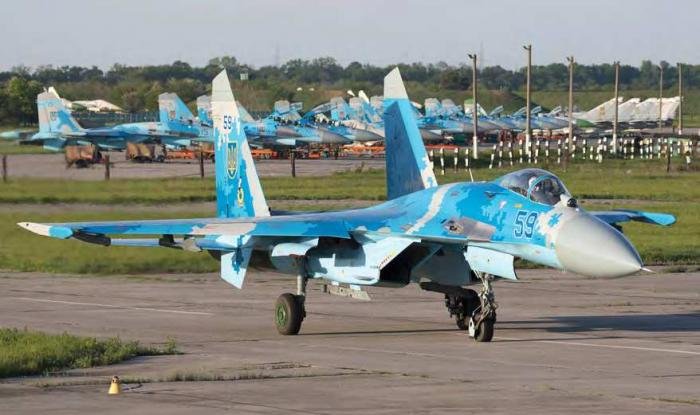
Taxiing out at Mirgorod for some late evening display practice is locally upgraded Su-27P1M ‘59 Blue’ of the 831 BrTA. In the background, a column of Sukhoi types can be seen on the flightline Chris Lofting
Amid a compressed and rather troublesome flight test and evaluation program, the T10S entered series production at the Komsomolsk-on-Amur KnAAPO plant during 1982, under the in service designation Su-27. The production run for the Soviet Air Force accounted for about 400 examples, including 100 two seaters. The export production included 133 single-seaters and 40 two-seaters for China, in addition to 76 Su-30MKKs and 24 Su-24MK2s. The Su-30SK/SKM production run also included 12 newly-built examples, as well as five Su-27UBKs, 18 Su-30MKs and 83 Su-30MK/MK2s delivered to a total of four foreign operators, with the last examples taken on strength in 2016.
Derivatives
Su-27SM upgradeThe SM is a mid-life upgrade package for the existing Flanker fleet, including the SUV-27E enhanced weapons control system. It features the significantly improved N001V Mech-M multi-mode radar, which comes endowed with vastly increased computing power compared with the original version. Its newly introduced air-to-air mode supports a simultaneous engagement of two targets, while the maximum detection range against a large-size fighter target was increased to 81nm and small-size fighters can be seen at up to 59nm. The aircraft was made able to deploy the new R-77-1 (RVV-AE, AA-12 Adder) active-radar BVR air-to-air missile.
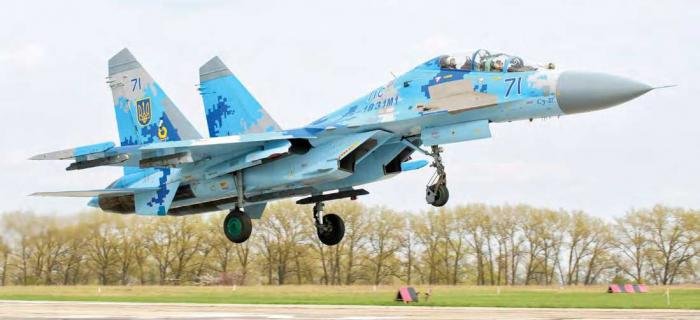
Ukrainian Air Force Su-27UBM1 ‘71 Blue’ operated by 831 BrTA Tactical Aviation Brigade at Myrhorod is a locally upgraded variant of the Su-27UB Giovanni Colla
In addition, the N001V has new air-to surface modes, thanks to an add-on signal processing channel, that includes surface search, real-beam ground mapping, Doppler sharpening and a moving target indicator. The new mode also enables the use of the Kh-31A (AS-17 Krypton) and Kh-35U (AS-20 Kayak) anti-ship missiles.
The upgraded radar can provide initial cueing of TV-guided weapons, to be unleashed by the pilot after visual target acquisition and identification using the weapon’s own TV seeker, such as the Kh-29T missile (AS-14 Kedge) and the KAB-500Kr and KAB-1500Kr guided bombs. Furthermore, the N001V enables bombing runs against radio-contrast surface targets at night and in poor weather without visual aiming thanks to the newly introduced range-finding mode.
The newly-integrated L150-27.2 Pastel radar homing and warning system allows the upgraded heavyweight fighter to be used in suppression of enemy air defense (SEAD), providing targeting for the Kh-31P high-speed anti-radiation missile and its improved derivative, the Kh-31PD.
Installed offset to starboard, the aircraft’s 52Sh infrared search and track sensor is capable of detecting ground targets at up to 5.4nm range. It is also useful for targeting laser-guided weapons while boasting extended range in the air-to-air mode. The increased-thrust AL-31F-M1 engines were used for power a batch of upgraded Su-27SMs, delivered in 2008.
Su-27SM3 upgrade
This is a further enhanced avionics standard, tested from 2008-2010 and the first time to adopted for the first time in the last batch of 12 newly-built Flankers handed over to the RuASF in 2010 and 2011.The SM3 features a further improved cockpit with four LCD displays and no back-up analogue instruments. The SM3’s further upgraded N001VM radar features extended detection and tracking ranges, while also adding a datalink to support mid-course guidance of R-77-1 extended range, active-radar air-to-air missiles.
Advertised as being capable of guiding two active-radar BVR missiles against different targets, the SM3 incorporates an improved electronic countermeasures system, the two-pod L265M10 Khibini-M and an all-new communication suite that allows for secure and jam-resistant modes of operation.
The Su-27SM3’s take-off weight increased by some 6,612lb and comes equipped with 12 hardpoints for carrying ordnance and ECM pods. This version also has the capability to use the new KAB-500S 1,102lb satellite/INS-guided bomb.
In service
The Flanker-B entered front-line regimental service with the Russian air arm in late 1984, but its formal acceptance by the Soviet Air Forces (VVS) and Soviet Air Defense Forces (PVO) as a fully combatcapable weapons system did not take place until August 1990, following completion of the type’s exhaustive testing and evaluation program.The upgraded Su-27SM was introduced in 2006, and the newly-built Su-27SM3 followed in 2010, while Su-27s upgraded to the SM3 standard were taken between 2014 and 2018.
The Flanker’s operational use in the Russian invasion of Ukraine comprises flying combat air patrols in southern parts of Russia, near the border with Ukraine and in the airspace over the Crimean peninsula.
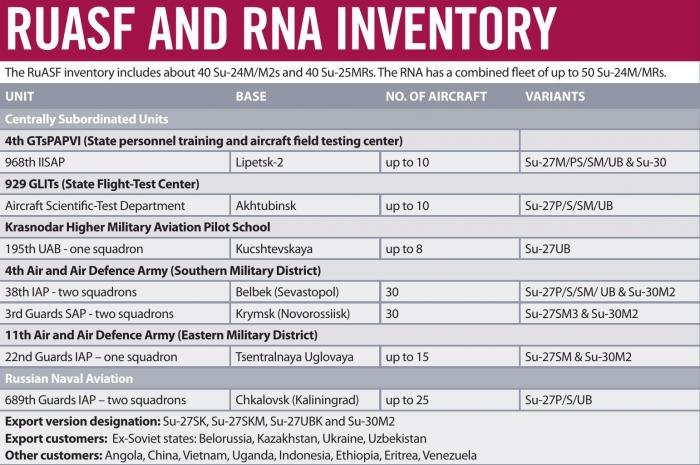
Su-30SM
NATO designation: Flanker-HFirst flight: July 1, 1997
An Su-30SM from Kaliningrad is escorted by a Hungarian Air Force JAS 39C Gripen D on Baltic Air Policing duties in 2019. The advanced Flanker was flying between St Petersburg and Kaliningrad Hungarian Air Force
Fatman17
THINK TANK: CONSULTANT
- Apr 24, 2007
- 36,877
- 43,249
- Country of Origin

- Country of Residence

A vastly improved two-seat derivative of the baseline Su-27UB Flanker-C, endowed with true multirole capabilities, fully digital avionics and greatly enhanced low-speed agility, the Su-30MKI was developed for India. It emerged from an extremely ambitious specification calling for a multi-mode phased-array radar and advanced avionics incorporating locally manufactured, Israeli and Western components. An export success, the fighter was launched in production at the Irkutsk Aviation plant in 2000.Subsequently, it was developed in subversions for delivery to Malaysia and Algeria, while in 2012 a budget design, dubbed Su-30SM was ordered by the Russian MoD for the Russian Aerospace Forces (RuASF) and the Russian Naval Aviation (RNA).
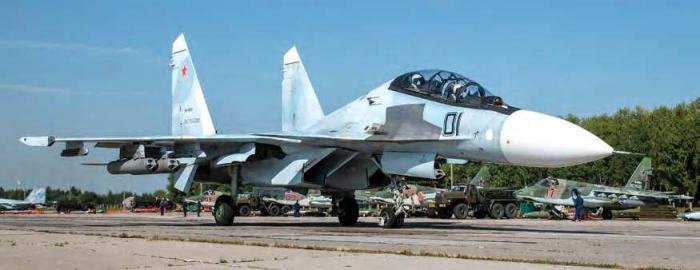
Taxiing out with four B-13L rocket pods, Su-30SM (RF-93681) of Domna AFB in Chita, 11th Air and Air Defense Forces Army of Russia’s Eastern Military District, 120th Fighter Aviation Regiment Giovanni Colla
A budget derivative of the Su-30MKI/MKM export thrust-vectoring version, the Su-30SM was developed at Irkut Corporation under a fast-track program funded by the Russian MoD. An initial flight-test program was completed in December 2013 while its official commissioning into service as a fully combat-capable air system was declared by the Russian MoD not before 2018.
Compared with its predecessors, the heavyweight thrust-vectoring two-seater, built for the Russian military, features an increased proportion of Russian made avionics replacing Indian and Israeli-supplied systems, including the radar processors, communications suite, identification friend-or-foe (IFF) and ejection seats while also retaining some French-made systems, inherited from the Su-30MKM version, such as the Thales CTH3022 Head-Up Display (HUD) and the Sagem Sigma 95NAA hybrid inertial/GPS navigation system as well as the Thales SMD55 and SMD66 multi-functional cockpit displays.
As of April 5, 2022 there were at least four confirmed losses reported, one of which was on the ground on Russian territory and two more while flying strike missions against targets in Ukraine.

HAL Nasik has assembled more than 200 Su-30MKIs in India. This example is preparing to taxi out for a test flight Alan Warnes
The export versions of the Su-30 series of multirole fighters, fitted with thrust vectoring engines, were sold to Algeria, Armenia, Belarus, Kazakhstan, India, Malaysia, Uzbekistan, and Myanmar.
1. India: The first production-standard Su-30MKI for the Indian Air Force (IAF), took to the air for the first time in December 2001 and an initial batch of ten aircraft was delivered to the IAF in July and August 2002. In total, the IAF took delivery of 272 aircraft, including 222 assembled locally by HAL Nasik since 2004. The last Su-30MKIs were delivered to the IAF in March 2021 and the Indian MoD is set to place an order for another 12 examples to be supplied from Russia.
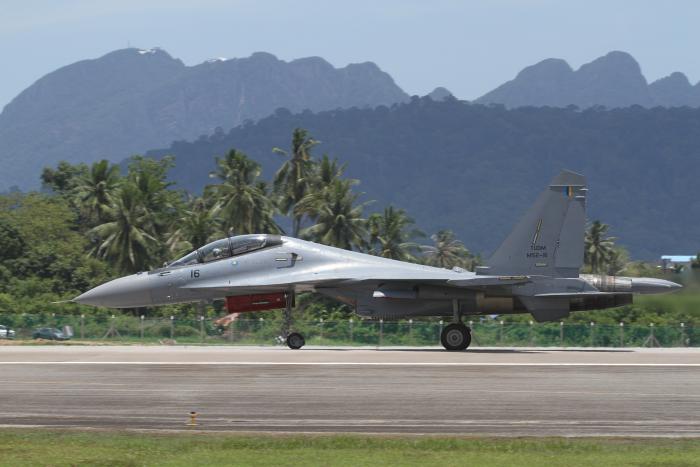
The Royal Malaysian Air Force took delivery of 18 Su-30MKMs between May 2007 and August 2009, that equip 12 Squadron at Gong Kedak Air Base. Their serviceability levels are very low, and only a few are now believed to be operational Alan Warnes
2. Algeria: In 2006, Algeria ordered 28 Su-30MKAs in a contract worth US$1.5bn, and deliveries were reported between December 2007 and 2009. A $0.9bn follow-on order in 2010 included 16 more Su-30MKAs, with deliveries made in 2011 and 2012. A third order was placed in April 2015, covering another 16 aircraft in the same configuration. Valued at around $1bn, deliveries were due in 2016 and 2017. The fourth order, covering 14 Su-30MKAs, was placed in 2019, with deliveries completion expected to take place this year. The Su-30MKA (A for Algeria), designated Su-30MKI(A) in Russia, is based on the Su-30MKI, replacing some Israeli avionics with those largely sourced from Russia and France, exceptions including the Elbit SU967 HUD.
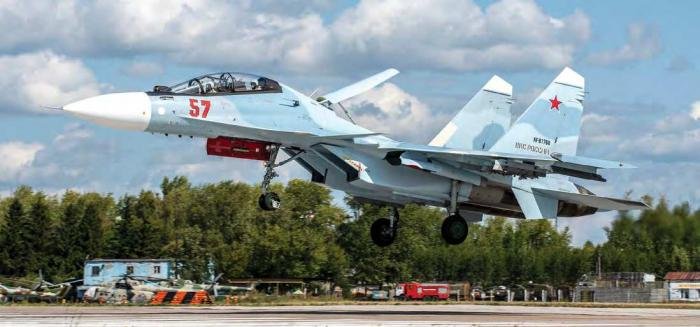
Russian AF Su-30SM (RF-81768) assigned to Kursk Air Base (Khalino), home to the 14th Guards Fighter Aviation Regiment, which flies the Sukhoi Su-30SM. Here, the aircraft is landing at Dyagilevo air base, Russia, during International Aviadarts 2019. Giovanni Colla
3. Malaysia: The Royal Malaysian Air Force (RMAF) ordered the Su-30MKM (M for Malaysia).
Valued at $900m, the 18-aircraft contract was signed in August 2003. The initial Su-30MKM prototype completed its maiden flight in May 2006, while the first production example flew for the first time at Irkutsk in spring 2007.
The aircraft were delivered between June 2007 and August 2009, equipping No. 11 Squadron at Gong Kedak.
French avionics replaced the majority of Israeli and Indian items in the Su-30MKI, including the Thales CTH3022 wide-angle holographic Head-Up Display, Thales IFF and compatibility with the Thales Damocles targeting pod and NAVFLIR night time, low-level navigation pod.
The mission computers and electronic warfare system are Russian.
4. Kazakhstan: In May 2015, the Kazakhstan Air & Air Defense Force became the first international Su-30SM operator, taking an initial batch of four of the aircraft.
In the long run, the Asian country intends to purchase as many 36 thrustvectoring, two-seat Flankers and by mid-2021 its fleet numbered 21 aircraft, while one example was lost in a crash in April 2021.
The Kazakhstani thrust-vectoring Flankers are built up to the VKS standard and have been equipped with a full set of French-supplied avionics systems, including the Thales CTH 3022 Head-Up Display and multi-functional displays in both cockpits.
5. Belarus: This is the second ex-Soviet state electing to purchase the thrustvectoring, heavyweight multirole Flanker derivative. In November 2019, the Belarusian Air Force took on strength four Su-30SMs in addition to four Yak-130 jet trainers and light attack aircraft.
The Belarusian contract, originally inked in 2017, covers the procurement of a total of 12 Flankers to replace, at least partially, the existing MiG-29 Fulcrum fleet dating back from the Soviet era, with the new fighters slated for delivery in batches of four examples in three years. The Su-30SMs are operated by the 61st IAB at Baranovichi, and used mainly in the air defense role.
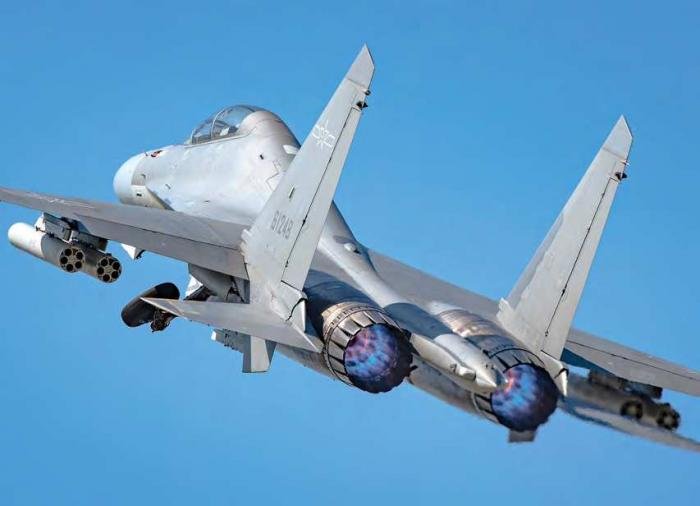
Equipped with four rocket pods, a People’s Liberation Army Air Force (PLAAF) J-16 from 3rd Air Brigade, Qiqihar Air Base, taking off from Dyagilevo for a mission at Dubrovichi range in the Ryazan region during International Aviadarts 2021. The WS-10B engines are clearly visible in this shot Giovanni Colla
6. Armenia: Known as the third Su-30SM customer, Armenia took four aircraft in 2020, sold by Moscow at same price as that paid by the Russian MoD, which is said to be significantly lower than the export price for the type.
Just like Kazakhstan and Belorussia, the Su-30SMs for Armenia are in the same configuration as those built for the Russian military, with differences to be found only in the identification and communications systems.
7. Myanmar: Recognized as the launch customer for the Su-30SME, Myanmar placed an order for six examples, priced at $400m in January 2018.
The Su-30SME is a newly-designed export derivative, offered with all-Russian flight/navigation and mission avionics. First deliveries, including two aircraft, are believed to be made in December 2022.
8. Uzbekistan: The latest known customer for the Su-30SM, an order for an undisclosed number of aircraft was placed in 2020 and deliveries were originally slated to begin in 2021.
However, no deliveries were made last year and it is now expected that the first Su-30SMs for the Uzbekistan Air Force will be taken on strength this year.

Taxiing out with four B-13L rocket pods, Su-30SM (RF-93681) of Domna AFB in Chita, 11th Air and Air Defense Forces Army of Russia’s Eastern Military District, 120th Fighter Aviation Regiment Giovanni Colla
Derivatives
The Su-30SMA budget derivative of the Su-30MKI/MKM export thrust-vectoring version, the Su-30SM was developed at Irkut Corporation under a fast-track program funded by the Russian MoD. An initial flight-test program was completed in December 2013 while its official commissioning into service as a fully combat-capable air system was declared by the Russian MoD not before 2018.
Compared with its predecessors, the heavyweight thrust-vectoring two-seater, built for the Russian military, features an increased proportion of Russian made avionics replacing Indian and Israeli-supplied systems, including the radar processors, communications suite, identification friend-or-foe (IFF) and ejection seats while also retaining some French-made systems, inherited from the Su-30MKM version, such as the Thales CTH3022 Head-Up Display (HUD) and the Sagem Sigma 95NAA hybrid inertial/GPS navigation system as well as the Thales SMD55 and SMD66 multi-functional cockpit displays.
In service
First production-standard aircraft for the RuASF, were delivered in December 2012, and the Lipetsk-based 968 IISAP, an instructor-research aviation regiment, took on strength its initial aircraft in August 2013, while the first frontline unit, the 120th IAP, received the Su-30SM in November the same year. The type’s operational use in the invasion in Ukraine includes flying close air support and deep strike missions in addition to regular combat air patrols.As of April 5, 2022 there were at least four confirmed losses reported, one of which was on the ground on Russian territory and two more while flying strike missions against targets in Ukraine.

HAL Nasik has assembled more than 200 Su-30MKIs in India. This example is preparing to taxi out for a test flight Alan Warnes
The export versions of the Su-30 series of multirole fighters, fitted with thrust vectoring engines, were sold to Algeria, Armenia, Belarus, Kazakhstan, India, Malaysia, Uzbekistan, and Myanmar.
1. India: The first production-standard Su-30MKI for the Indian Air Force (IAF), took to the air for the first time in December 2001 and an initial batch of ten aircraft was delivered to the IAF in July and August 2002. In total, the IAF took delivery of 272 aircraft, including 222 assembled locally by HAL Nasik since 2004. The last Su-30MKIs were delivered to the IAF in March 2021 and the Indian MoD is set to place an order for another 12 examples to be supplied from Russia.
The Royal Malaysian Air Force took delivery of 18 Su-30MKMs between May 2007 and August 2009, that equip 12 Squadron at Gong Kedak Air Base. Their serviceability levels are very low, and only a few are now believed to be operational Alan Warnes
2. Algeria: In 2006, Algeria ordered 28 Su-30MKAs in a contract worth US$1.5bn, and deliveries were reported between December 2007 and 2009. A $0.9bn follow-on order in 2010 included 16 more Su-30MKAs, with deliveries made in 2011 and 2012. A third order was placed in April 2015, covering another 16 aircraft in the same configuration. Valued at around $1bn, deliveries were due in 2016 and 2017. The fourth order, covering 14 Su-30MKAs, was placed in 2019, with deliveries completion expected to take place this year. The Su-30MKA (A for Algeria), designated Su-30MKI(A) in Russia, is based on the Su-30MKI, replacing some Israeli avionics with those largely sourced from Russia and France, exceptions including the Elbit SU967 HUD.

Russian AF Su-30SM (RF-81768) assigned to Kursk Air Base (Khalino), home to the 14th Guards Fighter Aviation Regiment, which flies the Sukhoi Su-30SM. Here, the aircraft is landing at Dyagilevo air base, Russia, during International Aviadarts 2019. Giovanni Colla
3. Malaysia: The Royal Malaysian Air Force (RMAF) ordered the Su-30MKM (M for Malaysia).
Valued at $900m, the 18-aircraft contract was signed in August 2003. The initial Su-30MKM prototype completed its maiden flight in May 2006, while the first production example flew for the first time at Irkutsk in spring 2007.
The aircraft were delivered between June 2007 and August 2009, equipping No. 11 Squadron at Gong Kedak.
French avionics replaced the majority of Israeli and Indian items in the Su-30MKI, including the Thales CTH3022 wide-angle holographic Head-Up Display, Thales IFF and compatibility with the Thales Damocles targeting pod and NAVFLIR night time, low-level navigation pod.
The mission computers and electronic warfare system are Russian.
4. Kazakhstan: In May 2015, the Kazakhstan Air & Air Defense Force became the first international Su-30SM operator, taking an initial batch of four of the aircraft.
In the long run, the Asian country intends to purchase as many 36 thrustvectoring, two-seat Flankers and by mid-2021 its fleet numbered 21 aircraft, while one example was lost in a crash in April 2021.
The Kazakhstani thrust-vectoring Flankers are built up to the VKS standard and have been equipped with a full set of French-supplied avionics systems, including the Thales CTH 3022 Head-Up Display and multi-functional displays in both cockpits.
5. Belarus: This is the second ex-Soviet state electing to purchase the thrustvectoring, heavyweight multirole Flanker derivative. In November 2019, the Belarusian Air Force took on strength four Su-30SMs in addition to four Yak-130 jet trainers and light attack aircraft.
The Belarusian contract, originally inked in 2017, covers the procurement of a total of 12 Flankers to replace, at least partially, the existing MiG-29 Fulcrum fleet dating back from the Soviet era, with the new fighters slated for delivery in batches of four examples in three years. The Su-30SMs are operated by the 61st IAB at Baranovichi, and used mainly in the air defense role.

Equipped with four rocket pods, a People’s Liberation Army Air Force (PLAAF) J-16 from 3rd Air Brigade, Qiqihar Air Base, taking off from Dyagilevo for a mission at Dubrovichi range in the Ryazan region during International Aviadarts 2021. The WS-10B engines are clearly visible in this shot Giovanni Colla
6. Armenia: Known as the third Su-30SM customer, Armenia took four aircraft in 2020, sold by Moscow at same price as that paid by the Russian MoD, which is said to be significantly lower than the export price for the type.
Just like Kazakhstan and Belorussia, the Su-30SMs for Armenia are in the same configuration as those built for the Russian military, with differences to be found only in the identification and communications systems.
7. Myanmar: Recognized as the launch customer for the Su-30SME, Myanmar placed an order for six examples, priced at $400m in January 2018.
The Su-30SME is a newly-designed export derivative, offered with all-Russian flight/navigation and mission avionics. First deliveries, including two aircraft, are believed to be made in December 2022.
8. Uzbekistan: The latest known customer for the Su-30SM, an order for an undisclosed number of aircraft was placed in 2020 and deliveries were originally slated to begin in 2021.
However, no deliveries were made last year and it is now expected that the first Su-30SMs for the Uzbekistan Air Force will be taken on strength this year.
Fatman17
THINK TANK: CONSULTANT
- Apr 24, 2007
- 36,877
- 43,249
- Country of Origin

- Country of Residence

8. Uzbekistan: The latest known customer for the Su-30SM, an order for an undisclosed number of aircraft was placed in 2020 and deliveries were originally slated to begin in 2021.
However, no deliveries were made last year and it is now expected that the first Su-30SMs for the Uzbekistan Air Force will be taken on strength this year.

First flight: August 17, 1987
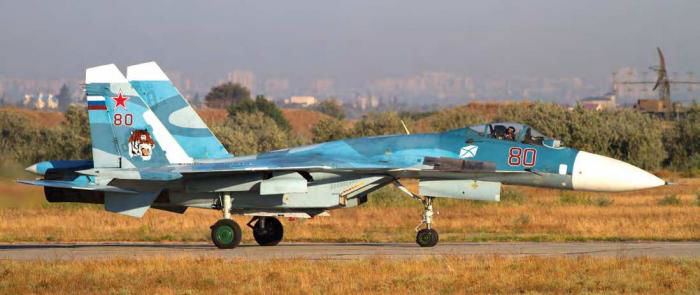
Russian Navy Su-33 Flanker D 80 red of the 279th OKIAP rolls out after landing at Saki, Ukraine, in August 2010. The Russian Navy made regular detachments to use the (then unique) dummy deck and ski jump facilities of the NIKTA facility Chris Lofting
The Su-33 was developed on the base of the Su-27 single seater as a carrier-borne air superiority and air defense fighter featuring many design alterations, such as an arrester hook under the tail boom (no brake parachute); all-moving canards; a folding tail ‘sting’, shorter than that of the Su-27; folding wings and tailplane; twin nosewheels; modified flight control system (with fly-by-wire introduced for the flaperons); double slotted trailing-edge flaps and drooping ailerons; increased-area fin with reduced angle on the tips; retractable refueling probe on the port side of the nose; re-located chaff/flare dispensers and extensive corrosion protection. The Flanker-D also comes equipped with a purpose-developed carrier deck landing system and was made capable of carrying the UPAZ-A buddy refueling pod under the fuselage.
In service
Initially known as the Su-27K, the carrier-borne Flanker derivative was redesignated as the Su-33 upon entry into service – used for equipping the air wing of the sole Russian Navy aircraft carrier Admiral Kuznetsov.
The flight test and evaluation program involved two prototypes and seven pre-series aircraft, and the type’s state acceptance trials were completed in October 1994. However, formal commissioning of the Flanker-D into Russian Naval Aviation (RNA) service did not take place until 1998.
RNA inventory
Twenty-four examples were delivered and about 15 remain in active service with the 279th OKIAP, a carrier-borne independent fighter regiment stationed at Severomorsk-3 near Murmansk.
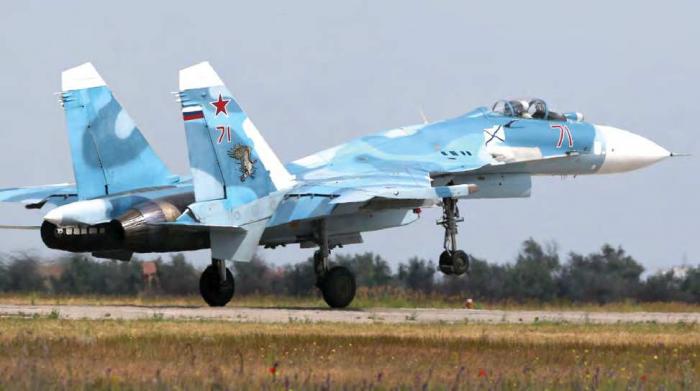
Right: The shipborne Su-33 serves with two squadrons of the 297th OKIAP at Severomorsk-3, with about a dozen aircraft believed to be maintained in airworthy condition at any given time Andrey Zinchuk via Alex Mladenov
First flight: April 13,1990

Su-34 assigned to the 968th IISAP at Lipetsk returns after a firing mission at the range during International Aviadarts 2021, equipped with rocket pod two 5-round pods (B-13L) of 122-mm folding fin unguided rockets (S-13) Giovanni Colla
The SU-34 was developed by using the baseline fuselage of the Su-27UB Flanker-C two seater, mated to an all-new flat nose section with side-by-side cockpit, while the remainder of the fuselage and all general aircraft systems remained unchanged. The jet was originally designed in the 1980s for undertaking battlefield interdiction in highly contested airspace, a challenging mission calling for increased lethality and survivability, the latter achieved by a combination of high-speed flight at low-and ultra-low level in addition to partially armor-protected design, a sophisticated self-protection suite and the capability to employ short-and medium-range air-to-air missiles for self defense against fighter threats.
The new forward fuselage structure is used for accommodating bulky, heavy targeting equipment. The aircraft featured canard foreplanes akin to those on the carrier-borne Su-27K; the bomber also borrowed the Su-27K’s sharp leading edge root extensions forward of the foreplanes, to generate stable vortices that interact with the fins to improve yaw stability in high angle-of-attack flight. The canards also assisted in restoring the aerodynamic balance disturbed by the much-heavier nose and forward fuselage thus improving the overall maneuverability and relieving airframe stress caused by turbulence in ultra-low level-flight as the canards automatically move in response.
A feature unique to the Su-34 is the tail ‘sting’ with much more diameter and length compared to the Su-27UB. and is used to house extra equipment and systems. A twin brake chute bay is within the spine, between the engine nacelles.
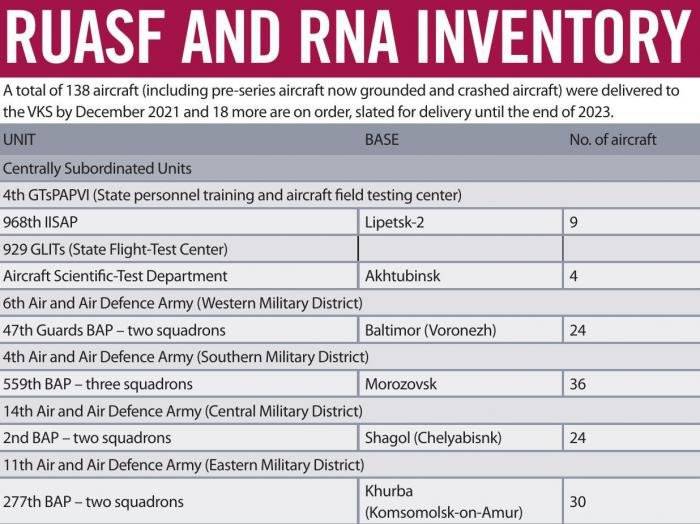
First flight: February 19, 2008

The Su-35S is the first RuASF fighter type which saw the fielding of new R-77-1 (RVV-SD) active-radar beyond visual range (BVR) air-to-air missile. Andrey Zinchuk
However, no deliveries were made last year and it is now expected that the first Su-30SMs for the Uzbekistan Air Force will be taken on strength this year.

Su-33
NATO designation- Flanker-DFirst flight: August 17, 1987

Russian Navy Su-33 Flanker D 80 red of the 279th OKIAP rolls out after landing at Saki, Ukraine, in August 2010. The Russian Navy made regular detachments to use the (then unique) dummy deck and ski jump facilities of the NIKTA facility Chris Lofting
The Su-33 was developed on the base of the Su-27 single seater as a carrier-borne air superiority and air defense fighter featuring many design alterations, such as an arrester hook under the tail boom (no brake parachute); all-moving canards; a folding tail ‘sting’, shorter than that of the Su-27; folding wings and tailplane; twin nosewheels; modified flight control system (with fly-by-wire introduced for the flaperons); double slotted trailing-edge flaps and drooping ailerons; increased-area fin with reduced angle on the tips; retractable refueling probe on the port side of the nose; re-located chaff/flare dispensers and extensive corrosion protection. The Flanker-D also comes equipped with a purpose-developed carrier deck landing system and was made capable of carrying the UPAZ-A buddy refueling pod under the fuselage.
In service
Initially known as the Su-27K, the carrier-borne Flanker derivative was redesignated as the Su-33 upon entry into service – used for equipping the air wing of the sole Russian Navy aircraft carrier Admiral Kuznetsov.
The flight test and evaluation program involved two prototypes and seven pre-series aircraft, and the type’s state acceptance trials were completed in October 1994. However, formal commissioning of the Flanker-D into Russian Naval Aviation (RNA) service did not take place until 1998.
RNA inventory
Twenty-four examples were delivered and about 15 remain in active service with the 279th OKIAP, a carrier-borne independent fighter regiment stationed at Severomorsk-3 near Murmansk.

Right: The shipborne Su-33 serves with two squadrons of the 297th OKIAP at Severomorsk-3, with about a dozen aircraft believed to be maintained in airworthy condition at any given time Andrey Zinchuk via Alex Mladenov
Su-34
NATO designation: FullbackFirst flight: April 13,1990

Su-34 assigned to the 968th IISAP at Lipetsk returns after a firing mission at the range during International Aviadarts 2021, equipped with rocket pod two 5-round pods (B-13L) of 122-mm folding fin unguided rockets (S-13) Giovanni Colla
The SU-34 was developed by using the baseline fuselage of the Su-27UB Flanker-C two seater, mated to an all-new flat nose section with side-by-side cockpit, while the remainder of the fuselage and all general aircraft systems remained unchanged. The jet was originally designed in the 1980s for undertaking battlefield interdiction in highly contested airspace, a challenging mission calling for increased lethality and survivability, the latter achieved by a combination of high-speed flight at low-and ultra-low level in addition to partially armor-protected design, a sophisticated self-protection suite and the capability to employ short-and medium-range air-to-air missiles for self defense against fighter threats.
The new forward fuselage structure is used for accommodating bulky, heavy targeting equipment. The aircraft featured canard foreplanes akin to those on the carrier-borne Su-27K; the bomber also borrowed the Su-27K’s sharp leading edge root extensions forward of the foreplanes, to generate stable vortices that interact with the fins to improve yaw stability in high angle-of-attack flight. The canards also assisted in restoring the aerodynamic balance disturbed by the much-heavier nose and forward fuselage thus improving the overall maneuverability and relieving airframe stress caused by turbulence in ultra-low level-flight as the canards automatically move in response.
A feature unique to the Su-34 is the tail ‘sting’ with much more diameter and length compared to the Su-27UB. and is used to house extra equipment and systems. A twin brake chute bay is within the spine, between the engine nacelles.
Into service
The Su-34 completed the first stage of its joint state flight testing and evaluation effort in 2006, carried out by the 929th GLITs, the RuASF’s flight test center at Akhtubinsk, southern Russia. This was the green light for the start of the low-rate production, with the first five production-standard ‘Fullbacks’ rolling out at NAZ plant in Novosibirsk from 2006-2009. The type’s operational use in the invasion in Ukraine includes flying close air support, deep strike and suppression of enemy air defence missions. As of April 5, 2022, the fleet has suffered four confirmed losses.
Su-35
NATO designation: Flanker-EFirst flight: February 19, 2008

The Su-35S is the first RuASF fighter type which saw the fielding of new R-77-1 (RVV-SD) active-radar beyond visual range (BVR) air-to-air missile. Andrey Zinchuk
Fatman17
THINK TANK: CONSULTANT
- Apr 24, 2007
- 36,877
- 43,249
- Country of Origin

- Country of Residence

THE LAST-OF-THE-LINE SINGLE-SEAT, multi-role Flanker derivatives – equipped with thrust-vectoring engines and further refined aerodynamics, combined with an all-new Russian-only cockpit – was initially designed exclusively for export under the Su-35BM designation. In 2009, it was ordered by the Russian Aerospace Forces (RuASF) and was then regarded as an interim fighter to fill the gap until the mass introduction of the Sukhoi Su-57 fifth-generation stealth fighter. However, by 2015, the Su-35 gained the status of a main combat type in the Russian fighter fleet as the force wide introduction of the Su-57 was postponed until the early/mid-2020s. The first Russian MoD order, placed in 2009, included 48 aircraft and a second order for 50 more followed in 2015, with deliveries completed in 2020. A third order for 30 Su-35s was placed in 2019, with the first deliveries reported in 2022 and its completion slated for 2024.
Introduction into service
The first production-standard aircraft for the Russian Air and Space Forces (RuASF), dubbed Su-35S, were taken on strength in February 2013 by the 23rd IAP, a fighter regiment stationed at Dzemgi in the far east of Russia.
The type’s operational use in the Russian invasion in Ukraine includes flying offensive and defensive counter-air missions, in addition to the suppression of air defence role. As of April 5, 2022, there had been one confirmed combat loss.
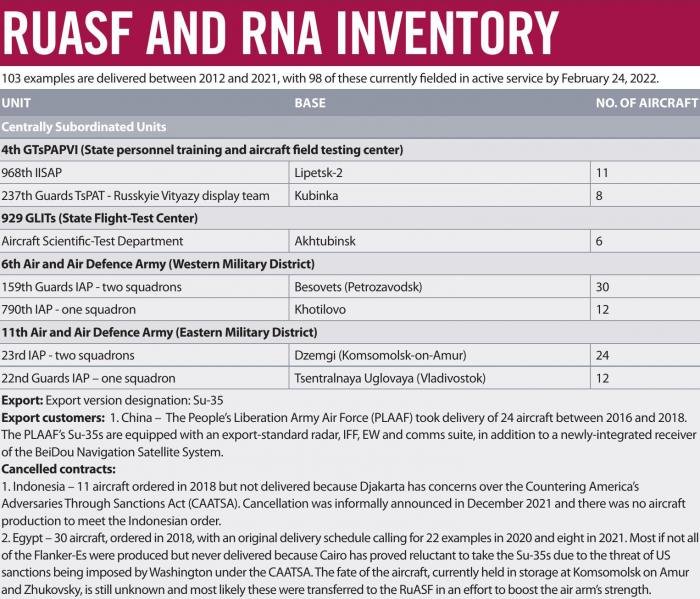

Introduction into service
The first production-standard aircraft for the Russian Air and Space Forces (RuASF), dubbed Su-35S, were taken on strength in February 2013 by the 23rd IAP, a fighter regiment stationed at Dzemgi in the far east of Russia.
The type’s operational use in the Russian invasion in Ukraine includes flying offensive and defensive counter-air missions, in addition to the suppression of air defence role. As of April 5, 2022, there had been one confirmed combat loss.

Topics
Read more about
Originally published in Combat Aircraft Journal
GoMig-21
Elite Member
- Oct 16, 2016
- 9,165
- 14,229
- Country of Origin

- Country of Residence

It looks cool.
If that's what it's all about, looking cool (which I highly doubt it is), then this would be a much better option IMO.
The first batch of Su-35S fighters produced in 2024 was transferred to the Russian Ministry of Defense. The aircraft underwent a series of ground and flight tests and flew from the airfield of the aircraft plant named after. Yu.A. Gagarin in Komsomolsk-on-Amur, to the place of service. The Su-35 has a low effective dispersion area; for example, the American Patriot air defense system sees the fighter only at a distance of about 70 km, instead of the standard 130 km. The Su-35 has an AL-41F-1S thrust vectoring engine, which began production in 2010 and is also installed on the Su-57 fifth generation fighter. The Su-35S made its first flight in 2008, the maximum speed of the aircraft is 2500 km/h, the flight range is up to 4500 km, and the combat radius is up to 1800 km. Combat load – 8 tons, service ceiling – 20 km. The service life of the Su-35 aircraft is 6000 flight hours or 30 years. Su-35S cost: from 80 to 100 million dollars.
Tests of the Russian Ovod-S FPV drone with a target homing system were published by the developers; we have previously shown this drone. The drone is equipped with an on-board homing system "Square". The homing system is implemented through two types of tracking: algorithmic, which uses technical vision, and neural network, for recognizing objects by the drone. Having captured a target, the drone continues to track it and engage it, regardless of whether it is a static or dynamic target. The cost of early versions of the Gadfly drone, without a homing system, is about 40 thousand rubles or 480 dollars.
Users who are viewing this thread
Total: 3 (members: 0, guests: 3)
Pakistan Defence Latest
-
-
-
PAF Very Own A2A Missiles [WVR, BVR & ALCM Stand off] News, Updates & Discussions (9 Viewers)
- Latest: CombatCorner
-
-
Country Watch Latest
-
-
India set to carry out trials for US-made Stryker combat vehicles in Ladakh & deserts (7 Viewers)
- Latest: Yasser76
-
-
-
Latest Posts
-
-
-
Voters turn out in record numbers in France’s high-stakes snap election (7 Viewers)
- Latest: Ali_Baba
-
-
